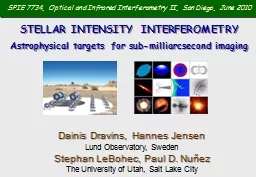

Dainis Dravins Hannes Jensen Lund Observatory Sweden Stephan LeBohec Paul D Nuñez The University of Utah Salt Lake City STELLAR INTENSITY INTERFEROMETRY Astrophysical targets for sub ID: 660710
Download Presentation The PPT/PDF document "SPIE 7734, Optical and Infrared Interfe..." is the property of its rightful owner. Permission is granted to download and print the materials on this web site for personal, non-commercial use only, and to display it on your personal computer provided you do not modify the materials and that you retain all copyright notices contained in the materials. By downloading content from our website, you accept the terms of this agreement.
Slide1
SPIE 7734, Optical and Infrared Interferometry II, San Diego, June 2010
Dainis Dravins, Hannes Jensen Lund Observatory, SwedenStephan LeBohec, Paul D. Nuñez The University of Utah, Salt Lake City
STELLAR INTENSITY INTERFEROMETRY Astrophysical targets for sub-milliarcsecond imagingSlide2
Intensity
interferomety:What, Why & How?Slide3
Narrabri
intensity interferometer
with its circular railway trackR.Hanbury
Brown: BOFFIN. A Personal Story of the Early
Days
of Radar, Radio
Astronomy and Quantum Optics
(1991)Slide4
Flux collectors at
NarrabriR.Hanbury Brown: The Stellar Interferometer at
Narrabri ObservatorySky and Telescope 28, No.2, 64, August 1964Slide5
INTENSITY INTERFEROMETRYSlide6
Intensity interferometry
Pro: Time resolution of 10 ns, say, implies 3 m light travel time; no need for more accurate optics nor atmosphere.Short wavelengths no problem; hot sources observableCon:
Signal comes from two-photon correlations, increases as signal squared; requires large flux collectorsSlide7
CANGAROO III
H.E.S.S.
MAGICVERITAS
AIR CHERENKOV TELESCOPESSlide8
CTA, Cherenkov Telescope Array
(2018?)An advanced facility for ground-based gamma-ray astronomy Slide9
Slide10
Digital
intensity interferometry Cherenkov telescopes: Large flux collectors Fast digital detectors & high-speed signal handling Combine optical telescopes in
software Huge number of baselines, no loss of digital signal 65 CTA telescopes: N(N-1)/2 = 2080 baselines Filled (
u,v)-plane enables sub-milliarcsecond
imagingSlide11
S/N in intensity interferometry
PROPORTIONAL TO: Telescope areas (geometric mean) Detector quantum efficiency Square root of integration time Square root of electronic bandwidthSlide12
S/N in intensity interferometry
PROPORTIONAL TO: Telescope areas (geometric mean) Detector quantum efficiency Square root of integration time Square root of electronic bandwidth Photon flux per optical frequency bandwidthSlide13
S/N in intensity interferometry
PROPORTIONAL TO: Telescope areas (geometric mean) Detector quantum efficiency Square root of integration time Square root of electronic bandwidth Photon flux per optical frequency bandwidth
INDEPENDENT OF: Width of optical passbandSlide14
Stellar diameters for different temperatures and different apparent magnitudes.
Dashed lines show baselines at which different diameters are resolved.OBSERVATIONS IN INTENSITY INTERFEROMETRYSlide15
For stars with same angular diameter but decreasing temperatures (thus decreasing fluxes),telescope diameter must successively increase to maintain the same S/N. When the mirrors become so large that the star is resolved by a single mirror, S/N drops.For stars cooler than a given temperature, no gain results from larger mirrors.R.Hanbury Brown, R.Q.Twiss: Interferometry of the intensity fluctuations in light III. Applications to astronomy,Proc.Roy.Soc.London Ser.A, 248, 199 (1958)
Original estimate of possible S/N as function of the stellar temperatureSlide16
SIMULATED OBSERVATIONS IN INTENSITY INTERFEROMETRY
Verification of simulation software against classical observations by Hanbury Brown et al.Left: Sirius observed with the Narrabri stellar interferometer (R.Hanbury Brown, J.Davis, R.J.W.Lake & R.J.Thompson; MNRAS 167, 475, 1974)Right: Simulated observations with
Narrabri instrumental parametersSlide17
Squared visibility (“diffraction pattern”), of a stellar disk of angular diameter 0.5 mas.Z = normalized second-order coherence
SIMULATED OBSERVATIONS IN INTENSITY INTERFEROMETRYSlide18
Squared visibility from a close binary star.
Left: Pristine image; Right: Logarithm of magnitude of Fourier transformSIMULATED OBSERVATIONS IN INTENSITY INTERFEROMETRYSlide19
Simulated measurements of a binary star with CTA-B telescope arrayLeft: Short integration time (noisy); Right: Longer integration time.
Color scale shows normalized correlation.OBSERVATIONS IN INTENSITY INTERFEROMETRYSlide20
Simulated observations of binary stars of visual magnitudes 3, 5, and 7.Total integration time: 20 hours; wavelength 500 nm, time resolution 1 ns, quantum efficiency = 70%
Array: CTA DSIMULATED OBSERVATIONS IN INTENSITY INTERFEROMETRYLimiting magnitudemv = 3mv = 5mv = 7Slide21
Simulated observations of binary stars OF different size(mV =
3; Teff = 7000 K; T = 10 h; t = 1 ns; = 500 nm; QE = 70%, array = CTA B)Top: Reconstructed and pristine images; Bottom: Fourier magnitudes.Already changes in stellar radii by only a few micro-arcseconds are well resolved.Slide22
SIMULATED OBSERVATIONS IN INTENSITY INTERFEROMETRYS/N independent of spectral passband
Simulated observations of rotationally flattened star with emission-line diskLeft: Pristine image, 0.4 mas across with 10 µas equatorial emission-line disk, 6 times continuum intensity Center: Observed magnitude of the Fourier transform in continuum lightRight: Same for a narrow-bandpass filter at He I 587 nm emissionStellar magnitude:
mv = 6, Teff = 7000 K; T = 50 h, QE=70%; Array = CTA ISlide23
Top: StARS
shapeD by rapid rotation; Middle: DISKS & WINDS; Bottom: STELLAR SURROUNDINGSSlide24
Simulated observations of a Cepheid-like star undergoing non-radial pulsations mV =
3.4; Teff = 7000 K; Δt = 1 ns; = 500 nm; Array = CTA BLeft: Pristine image; Right: Observed Fourier magnitude
NON-RADIAL PULSATIONS & VELOCITIES ACROSS STELLAR SURFACESObservations through very narrow bandpass filters, spanning one spectral line(might require ordinary telescopes rather than Cherenkov ones) Slide25
“
Our local Universe is teeming with stars, but despite 400 years of telescopic observations, astronomy is still basically incapable of observing stars as such!Although we can observe the light radiated by them, we do not (with few exceptions) have the capability to observe the stars themselves, i.e., resolving their disks or viewing structures across and outside their surfaces (except for the Sun, of course!).One can just speculate what new worlds will be revealed oncestars no longer will be seen as mere point sources but as extended and irregular objects with magnetic or thermal spots, flattened or distorted by rapid rotation, and with mass ejections monitored in different spectral features as they flow towards their binary companions.It is not long ago that the satellites of the outer planets passed from being mere point sources to a plethora of different worlds, and one might speculate what meager state extragalactic astronomy would be in, were galaxies observed as point sources only.”(Dravins & LeBohec, SPIE Proc.
6986, 2008)In 2009, we celebrated400 years oftelescopic astronomySlide26